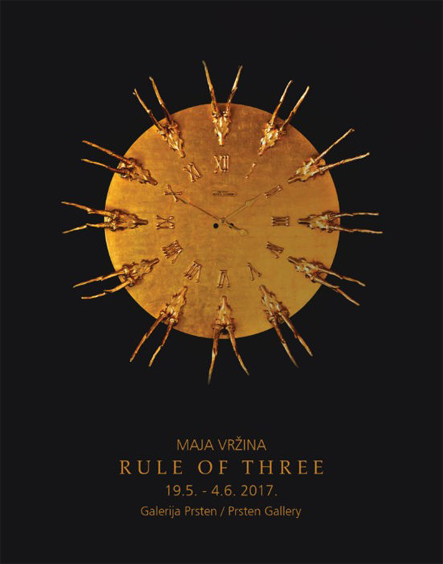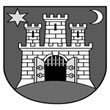
Exhibition preface by Iva Körbler:
RULE OF THREE
For the first time Maja Vrzina’s artistic style and identity make a representative appearance in contemporary Croatian art as a unique authorial voice. In just a few years after exchanging her homeland for the London art scene, the artist managed to establish herself by her unique stylistic and artisanal technique. Her manner of expression reveals a very complex vision of reality, but also an attempt to create her own morphology, which is not directly related to any stylistic tendency or trend.
If we see the whole 20th century as a century of melancholy, the dark period of human history in which the world has almost been destroyed several times – the fact reflected in a number of artistic oeuvres of European and Croatian artists during the two most prominent movements; Informel and existentialism – then we can find the same stylistic, emotional and spiritual codes in Maja Vrzina’s oeuvre, presented through the morphology of the surreal stylization of her drawings.
Her black-and-white world, which clearly shows the polarities of life and death, birth, and death, light and darkness, looks like a playful stage of surreal and fantastic visions, dreams and subconscious, but only at first glance. We can clearly feel, not only existential anxiety but also the evocation of loneliness and isolation, figuratively and literally “stopped“ at the edges of the painting by a gilded frame, which acts as a symbol of (self-)renewal and new life. According to the artist, aside from letting oneself go to the currents and temptations of life and emotions, one should also seek to find a real and metaphorical balance. This should be done by taking steps ‘beyond the frames’, rules, clichés and conventions, and by carefully trying to create a fragile framework within which we can protect ourselves from the external world – our own golden cage.
In these black-and-white polarities, the introduction of gold, not only in terms of its color, material but also its energy imprint and frequency, point to the idea of durability, wisdom, existence of noble virtues, as well as the balance between male and female principles. The motifs of sun and gold bear the ancient symbolism of visible divine goodness, transcendental source of light, and it is, in fact, a great mercy to have the power of golden sunrays shine upon us in this world. Golden colour in Maja Vrzina’s works speaks of her perfectionist nature, the possibility to achieve (utopian) perfection, both in life and art. The long and complex process of applying gold leaves, preceded by “stuffing“ the frame or sculpture, can point not only to the aspiration for perfectionism or eccentric hedonism, but also to a meditative and process oriented dimension of her work, which can easily escape the observer due to effective, shiny final impression of the work.
The atypical sculpture-object, or sculpture-clock, as a metaphorical eye of the time (Time is precious, 2012), which truly does function as a clock mechanism, once again points to a mannerist and surrealist perception of the world. However, it also points to the hermetic and esoteric tradition: both the European artworks of the 16th century and Surrealist works of the 20th century are full of strange, bizarre clocks; it is like the artists want to emphasize the shift between the external and one’s own, internal, perception of the dimensions of reality and difference in the passage of chronological, biological and conventionally measured time. The illusion of time and space is thus emphasized to the highest extent, but Maja’s cabinet of wonders does not stop here: not only have the gold-stuffed horned animal heads been added to the clocks, but Roman numerals on the clock – a stylized sun disk – have also been made of real animal bones, which is a Surrealistic gesture par excellence! Bones in the work represent the symbol of our sacrifice and suffering, existential suffering and demonic deals we sometimes have to make in order to survive.
However, in her last sculptural work, a whole composed of three mixed media sculptures; combination of wood, resin and gilding (Transitions, 2017), Maja Vrzina elaborates three important phases in a woman’s life. First we see an ideal, happy and balanced woman-sun carrying a new life inside of her (a woman at the peak of her strength and beauty), then a woman-alien, true extra-terrestrial – which most often pregnant women are! – and a new woman-mother who, like a primeval mother-monkey, just cares about the feeding schedule of her newborn due to evolutionary reasons.
If we were, for example, to compare Maja Vrzina’s picto-drawings with Nives Kavuric Kurtovic’s drawings based on their spiritual relationship, then we could clearly see the inclination towards the so-called idea of balance of life experiences in Maja’s work. Here, the existence does not end in darkness and nothingness, but the possibility of a new life brings it closer to the drawing oeuvre of Snjezana Kodaric Ivankovic. In Maja Vrzina, as in both of these artists, there is a prominent inclination towards the idea of drawing as a visual intimate diary, psycho-emotional therapy, process of leaving the traces of existence in matter. It seems to me that the contemporary art that touches us is becoming more and more like this, ranging between emotional extremes, depression and thirst for the ultimate feeling of life, as if sensible artists are aware that, once again, they share their lives with the visions of the possible destruction of the world.
In a desire to overcome these dark premonitions and fears, Maja Vrzina’s paintings also talk about female identity, archetypes of growth, flourishing – and decline – covering all the phases of a woman’s life. However, these phases do not unambiguously end in this context, but can also be related to the alchemical transformations of forms seen in the oeuvre of the graphic artist and painter Josip Zanki. A strong biomorphic element in Maja’s paintings, which unfolds before us in a series of plans, overlaps, and where the motif of a female / her own face is delicately embedded in the epic poem to Nature, connects her works with the mannerist stylization that at first seems like an ‘aesthetic buffonata’ (Hocke). But this is actually a painful scream of an artist lost in the imposed time and space. Eyes in the paintings are often closed in a dreamy-melancholic escape from this world or struck with horror and ‘frozen’ on something beyond the painting. This also brings her work closer to surreal, introverted worlds of the graphic artist Zdenka Pozaic (motifs of shells, flowers, leaves, her own face) which introduce the idea of pantheistic saturation of Nature, but also of meditative-contemplative drawing that will lead us back to the great topic of persistent saturnian melancholy that can also be found in today’s middle generation of artists. However, in Maja’s paintings there are certain moments of a happy and satisfied smile, happiness that does not want to be uttered out loud. Picto-paintings on the themes of artists as a child / self-portrait, mother, lovers, lost child, queen of darkness and light, angel, prophet and swan with the theme of eternal love point to a personality that is both romantically coded, but also an unbreakable Amazōn, which also gives a slightly feminist discourse to Maja’s works.
However, at no moment does Maja Vrzina careen towards the dangerous edge of decorativeness or calculated likeness of the image, and her works have a noticeable potential of art illustration, for children’s and serious literature alike.
Maja Vrzina’s oeuvre proves that sometimes we have to go far from our roots in order to come back refined with different, mature and courageously acquired life and artistic perception of things. Because, without a doubt, this artist has a great artistic and creative potential of a clearly recognizable and already well-formed personal style.
Co-organizers:

Supported by:

Sponsors:

Media sponsor:

Home of Croatian Association of Artists, HDLU – Meštrović Pavilion Trg žrtava fašizma
16, Zagreb, T + 385 (0) 1 46 11 818, 46 11 819 F + 385 (0) 1 45 76 831 E-mail: info@hdlu.hr
www.hdlu.hr
ENQUIRIES
To enquire further about Maja's work, please use the form below. Please include your telephone number if you would prefer to be contacted this way. We aim to respond to all enquires within 48 hours.
CONTACT MAJA VRZINA
SELECT PR
Jaruščica 5
Zagreb
Croatia
Photography by Croatian Embassy in London

